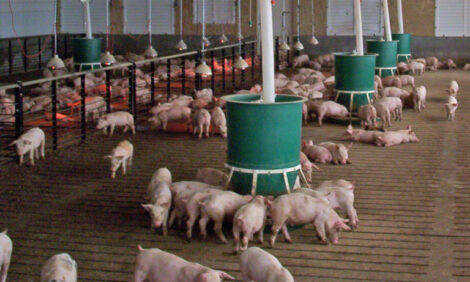



Piglets Overcoming Post-Weaning Stress
Achieving good performance in growing pigs starts with ensuring the sow produces enough milk and after weaning, pathogenic bacteria can be combatted by feeding a combination of organic acids, cinnamaldehyde and a permeabilising substance, according to Biomin.Weaning is no doubt a challenging event in the life of a piglet. How a piglet is getting over this stressful period in its life is a matter of many different factors. The most obvious is to provide the animal with a diet sufficient in nutrients in order to make sure the nutritional needs of the piglets are met. But also factors such as weaning weight, which is closely related to the performance of the sow during lactation and the sow’s milk yield, are major factors influencing the post-weaning piglet performance.
Problems occurring after weaning such as diarrhoea and the post-weaning growth check are widely spread and cause severe economical losses to the livestock producer. Performance post-weaning has, for example, a strong influence on the time to reach market weight as pigs not suffering from the post-weaning growth check requiring less days to reach market weight. Post-weaning performance is a result of the weaning weight (Figure 1), as pigs that are heavier at weaning are less likely to suffer any adverse effects due to the change they are undergoing post-weaning.
Weaning weight is, in turn, a result of their performance during suckling which is amongst other factors such as creep feeding also a matter of the lactation performance of the sow. The main goal during suckling is to avoid severe weight loss of the sow by maintaining optimum feed intake so that the sow is able to have optimum milk yield and, therefore, ensure optimum growth of the piglets. This is only the case if the sow has a sufficient feed intake from day one of the suckling period. Feed intake after weaning or if the sow is eating at all also depends on the farrowing time as prolonged farrowing has detrimental effects on the welfare of the sow. A prolonged period of labour pain is associated with a slower recovery from farrowing. An exhausted sow is less reactive, which most likely leads to a reduction in post-farrowing feed intake.

Optimising Farrowing
The reasons for prolonged farrowing are diverse but most likely related to a lack of calcium, which is needed for muscle contraction. Urinary pH is influenced by the acid-base balance of the feed and has strong effects on the acid-base balance of the body. Increasing the anions of the diet results in acidic stress of the sow. Depending on the extent of acidic stress, the sow may enter a metabolic stage often referred to as metabolic acidosis. It is reported that acidic stress leads to an increase in the net excretion of calcium from the body by increasing renal calcium excretion. The body tries to compensate for this deficiency by increasing mobilisation of calcium from the bones, which is the biggest calcium storage of the body. At the same time, the body also tries to buffer the blood pH via increasing calcium resorption regulated by the parathyroid hormone and vitamin D, which results in increased calcium blood levels.
As during gestation more calcium is available for the sow as it is needed, the parathyroid hormone/vitamin D mechanism is not trained, which might lead to problems during farrowing due to a lack of calcium available for muscle contractions. This mechanism can be trained by feeding anionic diets. An effective way to increase anions in the diet is by adding a mixture of an inorganic acid, anionic substances and plant extract to a diet incorporated in products such as Biomin® pHD. This increases the anions in the diet, which leads to metabolic acidosis and the release of calcium, which results in shorter farrowing and a good start for the sow into lactation.
Other Health Threats
Short farrowing times can lead to better feed intake of the sow post-weaning, which in turn leads to optimum milk yield, hence optimum growth of the piglets during suckling period and high weaning weights.
Even if high weaning weights can be achieved, weaning itself still remains to be a very stressful event in the life of a piglet. Severe changes such as the change of the diet from liquid to solid, the removal of the piglets from their litter-mates as well as changes in the environment puts the newly weaned piglet under enormous stress and research has shown that it may take the piglet up to the second or third week post-weaning to consume a comparable amount of energy and grow at the same rate as prior to weaning. Especially during that time, piglets are extremely vulnerable and the immune system weakened. This means that even if the piglet was provided with an optimum start into life by a sufficient milk supply of the sow resulting in high weaning weights, health threats remain as the presence of pathogenic bacteria can cause severe harm especially in times in which piglets are vulnerable and the immune system weakened as it is the case in the time post-weaning.
Organic Acids
Organic acids have been used in animal nutrition for decades. They not only have beneficial effects on feed, as they lower the pH creating unfavourable conditions for pathogenic bacteria, which leads to a reduced intake of pathogens by the animal. Organic acids also have antimicrobial effects within the animal’s gastrointestinal tract (GIT).
Also in the GIT, organic acids lower the pH, creating unfavourable conditions for pathogenic bacteria. However, organic acids in their non-dissociated form can penetrate the cell wall of bacteria. Within the bacteria, they dissociate, reducing intracellular pH. The cell tries to restore the normal pH, which is a process requiring energy. Furthermore, inside the cell, anions accumulate, which disrupts the DNA and protein synthesis and the membrane so that the bacterial cell cannot replicate.
However, the antimicrobial effects of organic acids especially on gram-negative bacteria are limited, as gram-negative bacteria have an outer membrane, which serves as an additional barrier against external agents, which might damage the bacteria. Therefore, organic acids were often combined in the past with other nature-identical compounds in order to combat pathogenic bacteria more effectively.
Cinnamaldehyde
Combining organic acids with cinnamaldehyde was shown to have synergistic effects on the inhibition of pathogenic bacteria as shown in vitro.
This is not surprising, considering cinnamaldehyde’s mode of action as it plays a major role in cell division of potentially harmful bacteria targeting the so-called FtsZ protein. Under normal conditions, FtsZ polymerises into filaments, which assemble at the place within the cell where the cell division takes place into the polymeric structure known as Z-ring. The Z-ring is responsible for the cell division. Cinnamaldehyde inhibits not only the formation of FtsZ into filaments, but also inhibits essential processes involved in the Z-ring formation and its function. This impairs the cell division and results in a reduction of the bacterial load within the gastrointestinal tract.
Gram-Negative Bacteria
As indicated, effects of nature-identical compounds on gram-negative bacteria are limited due to their outer membrane protecting the cell from possibly harmful substances. However, weakening this outer membrane is possible by substances commonly referred to as permeabilisers. There are known to be many permeabilising substances but they act differently: some remove stabilising cations from the outer membrane, others bind to the outer membrane resulting in the loss of barrier function. Others again destabilise and disintegrate the outer membrane or displace cations from the outer membrane. However, all have the same end effect, which is to damage the outer membrane, facilitating the entry of external substances, which are capable of inhibiting or destroying cellular functions, into the cell, resulting in sub-lethal injury of the bacteria.
Influence on Growth Performance
It has been shown in vitro that a combination of organic acids, cinnamaldehyde and a permeabilising substance, launched as Biotronic® Top3 has beneficial effects on the inhibition of pathogenic bacteria. Combating pathogenic bacteria has also beneficial effects on growth performance of animals. Bacteria compete with the host for nutrients, secrete toxic compounds, decrease fat digestibility, stimulate rapid turnover of absorptive epithelial cells, require an increased rate of mucus secretion by intestinal goblet cells, and stimulate immune system development and inflammatory responses.
All of these effects negatively impact growth performance. Therefore, it is not surprising that when pigs were fed a diet containing an organic acid blend, cinnamaldehyde and a permeabilising substance over a 56-day post-weaning period had a six per cent higher final body weight, ate five per cent more, had an eight per cent increased daily weight gain and a feed conversion ratio three per cent better than the control group (Table 1).
| Table 1. Performance of pigs fed a diet containing a mixture of organic acids, cinnamaldehyde and a permeabilising substance compared to a control group | |||
| Negative control | Biotronic® Top3 | Change, % | |
|---|---|---|---|
| No. of animals | n = 30 | n = 30 | |
| Initial body weight, kg | 8.75 | 8.72 | / |
| Final body weight, kg | 35.62a | 37.69b | +6 |
| Feed intake, g/animal | 982 | 1028 | +5 |
| Daily weight gain, g | 481a | 517b | +8 |
| FCR | 2.04 | 1.99 | -3 |
| a,b Means with different superscripts differ significantly; P<0.05 | |||
In conclusion, the first step in feeding the piglet is to make sure that the sow has an adequate milk yield, which can be achieved by making sure that farrowing is running smoothly and the sow achieves a high feed intake as soon as possible after farrowing. However, even if piglets are healthy and have a high weaning weight, the stressors they are exposed to not only around weaning but during the whole grower stage represent an enormous health threat and make it easier for pathogenic bacteria to exert adverse effects on the pig’s health and associated performance. Therefore, serious effort has to be put in to effectively combating pathogenic bacteria in any case. This can be achieved by combining organic acids, cinnamaldehyde and a permeabilising substance.
November 2011








